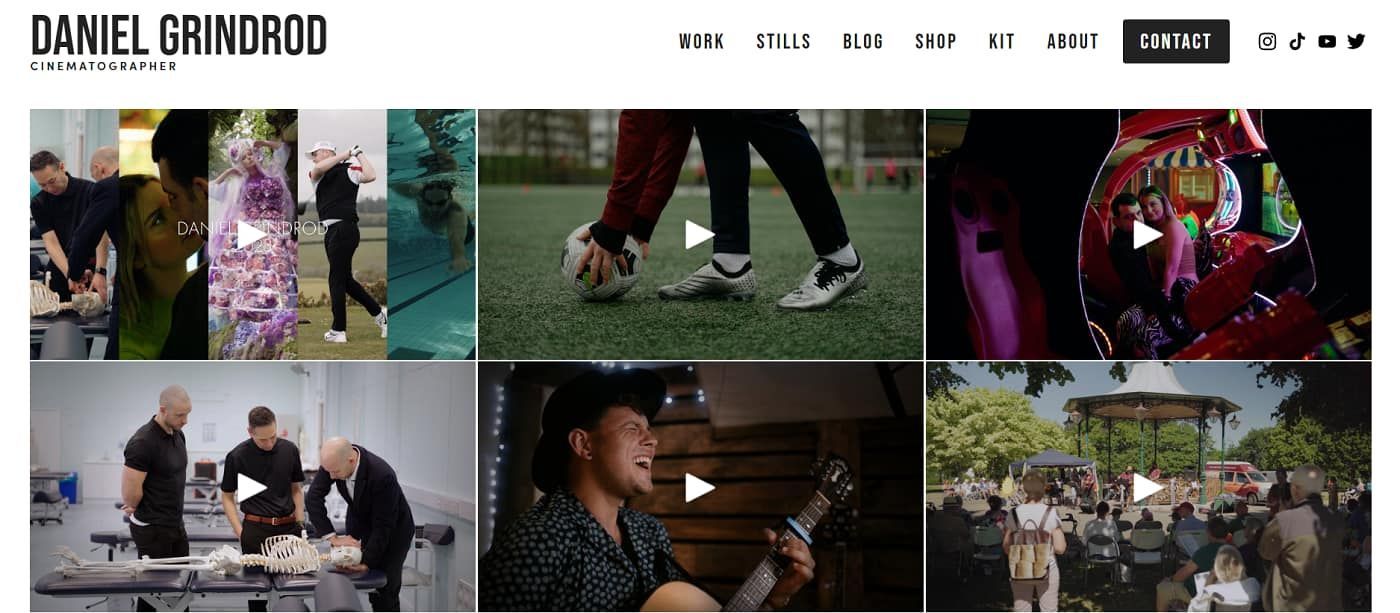How To Create A Freelance Portfolio From Scratch In 2024
By Adrian Mole Updated: Mar 29, 2024

Boost Your Freelance Success With These Proven Strategies
The gig economy is growing by leaps and bounds, and to stay competitive, freelancers need an online presence to showcase their skills and experience.
Your online profile could be a personal blog or website, a social media presence on LinkedIn or X, or YouTube videos showcasing examples of your work.
To be successful, you need to sell yourself 24/7 and the best way to do that is to create an online portfolio that drives clients to your best work.
What Is A Freelancer Portfolio?
The purpose of a freelance portfolio is to give potential clients a place to see what you can do, showcasing your work or services.
Your freelance portfolio may consist of a brief overview of your skills, an explanation of your expertise, and examples of past projects.
This will allow potential clients to assess your work and see what your capabilities and style are like to compare them against their gig requirements.
According to a recent survey, over a third of the workforce were engaged in freelance work last year, so it’s important that you stand out.
Your freelance portfolio is similar to a resume which highlights key roles you’ve fulfilled, some of your most notable achievements, and results you’ve achieved.
You have the perfect opportunity to exhibit past work examples so that your client can envision your abilities in web design, copywriting, brand development, etc.
It is the best way to take advantage of what the gig economy offers and allow your high-quality work to stand out from the rest.
Why Do You Need A Freelancer Portfolio?
There are always many more applicants for a particular job than work available, so a freelance portfolio is a great way to enhance your credibility.
By showcasing your work, you provide a track record of success that gives you a competitive advantage over other applicants.
It shows clients that you care about the work you do and have the necessary skills and experience to be of value to them and their company.
A professional freelance portfolio also enhances your value proposition, allowing you to charge more for your services by proving your worth.
If you are new to freelancing and don’t have any previous client work to display, you can provide portfolio samples of your work – proving your competence.
This is a sure way to ensure that you get the best gig economy jobs and enjoy success as a professional freelancer.
Freelancer Portfolio Website Examples
Once you have your basic information and portfolio of work, it’s time to create your freelance portfolio website – but where to start?
To help you decide on a design and see what other freelancers include in their portfolios, we’ve selected three superb examples of successful websites:
1. Daniel Grindrod

Meet Daniel Grindrod, he’s a cinematographer who knows just how to grab people's attention with his captivating online portfolio of work.
His hero section is filled with attractive videos and photos, so you’re in no doubt about what he can do for you.
The website design is clean and minimalist, with clear navigation at the top and a bold contact link to get in touch with him easily.
2. Hank Herman

An accomplished author, humorist, and writing instructor, Hank Herman provides visitors with an entertaining introduction to his work with an unusual website design.
He kicks off with a testimonial from a trusted source and follows up with a succinct “About” section to introduce himself.
This leads into his portfolio that highlights his skills and interests and includes graphical links to his most popular work.
3. Anita Chauhan

This freelancer’s website is crisp and clear with very little to distract from its main function - which is to make contact easy.
It’s easy to get in contact with Anita Chauhan as simple text and minimal distractions on her home page provide just enough information.
These three portfolio websites are easy to follow, there are minimal distractions, and they give just enough information to tweak your interest.
How To Create A Freelancer Portfolio (Step-By-Step)
If you’re new to freelancing or have some experience but want to improve your chances of getting more jobs, you need a professional-looking portfolio.
Your best option is to follow a step-by-step approach to create an enticing and informative visual presentation of your skills and experience.
Once you’ve decided on the type of work you want to do, keep your freelance portfolio updated with your latest, most relevant examples.
These are the steps you can take to create a freelance portfolio in 2024:
Step 1: Pick Your Niche
The best way to shine in the gig economy is to pick a niche and present yourself as the best, most experienced choice.
Your niche should align with your background or interests, and clients should recognize that you are an expert by your words and design.
With more than 38% of the workforce engaged in freelance work, picking a niche is vital to your future success.
There are numerous ways that you can pick your niche, including by industry, location, demographic, experience, even price.
Become The Answer
The best freelance opportunities are those that solve problems in niches with less competition – your job is to become the answer.
You may be concerned that by narrowing down the subject matter, you’ll miss out on opportunities outside your core offering, but that is simply not the case.
If you decide to work in a particular industry, dentistry, for instance, you have tens of thousands of potential clients across the country.
Minimize Your Competition
You cannot possibly work with all the clients, so consider deciding on a particular city or state and tailor your online portfolio to their needs only.
This niching-down process can be extended further by only working with a certain type of dentist, such as cosmetic dentists or oral and maxillofacial surgeons.
By embracing the idea of being the go-to resource in one niche rather than trying to cater to everyone, you minimize your competition.
This phenomenon was studied by Harvard 20 years ago and the resulting Blue Ocean Strategy has proven itself to be very effective.
Step 2: Select Your Samples
Now that you know which niche you’re going to target, you must decide on the samples of work that you’ll include in your online portfolio.
Let’s start with new freelancers who don’t have any prior projects that they can showcase - what can they do?
Start by visiting employment sites like Gigster or TaskRabbit, two of the biggest gig economy companies, and look for the types of jobs that you want.
Create Samples
Select a couple of jobs and create a sample based on what the client needs, making sure to make it your best work.
If you are a graphic designer, then create contemporary designs, or if you offer web design, create a personal website.
Often, a graphic designer and web designer will work together with an SEO writer to create a website for a client for free to enhance their portfolios.
You can then use these practice projects as samples on freelance professional portfolio websites if you lack previous projects to display.
One doesn’t need a lot of examples, so long as the projects are high quality and showcase skills and experience effectively.
Offer To Work For Free
Offer to do work for free, explaining to potential clients that you are building your portfolio, especially if you create websites or do search engine optimization.
Not only will you have examples to include on your website, but you can ask for testimonials if the client is very happy.
You can find the perfect client to work with on gig economy platforms, but without samples of your work, you’ll not have much luck.
Step 3: Educate Your Ideal Client
The best way to prove to your client that you know what you’re doing is to describe your process in detail.
You can not only do this in your portfolio, but you can write about it on social media or in industry newsletters, proving your value.
This not only identifies you as someone who has industry knowledge, but it also demonstrates that you are organized and confident in your abilities.
Reveal Your Secrets
Create a section in your portfolio that highlights the features and benefits of working with you by letting your client see your process.
A feature is the service or thing that you provide, and the benefit is the value that the client receives from the service.
You can differentiate yourself from other freelancers by giving each step in the process a unique name that describes its value.
Highlight Your Value
Summarize your process by pointing out that the success of your service or product is due to the value you add through a systematic process.
This is a way of pre-selling your potential client by demonstrating the value you add before you even get into quoting on a job.
Step 4: Highlight The Projects You Want
Once you’ve identified your niche, you need to let your prospective clients know what type of projects you want to work on.
You’ll not always be able to work on the exact projects you’d like to, but it helps to clarify which projects you prefer.
Describing your ideal projects helps prospective clients to see your interests, and they may even hire you over more-qualified freelancers.
You’ll also be more enthusiastic when describing your ideal project, which makes you more persuasive when selling your services.
Another way to attract your perfect client is to only showcase projects and types of work that you want in your portfolio.
Avoid providing too much information or too many samples of your work and focus on highlighting three to five of your best examples.
Step 5: Education And Experience
To help build your brand, you need to include details of your education as well as a list of your experiences to impress potential clients.
Include the names of the institutions you attended, any courses, degrees, or certificates you earned, and any high-profile employers or clients you worked with.
Cultivate Your Soft Skills
Aside from your skills and experience in your target industry, your prospective clients also value skills like being on time and good communication.
A study conducted in 2021 estimates that most of the jobs in America will be filled by freelancers by 2027, so your brand must look good.
Become A Storyteller
The best way to convey soft skills like a sense of humor and positivity is to include them in the stories you tell and the examples you highlight.
Showing rather than telling gives more weight to your portfolio and is a major factor in a client deciding whether to hire you or not.
Clients want to work with people who are easy to get along with, meet deadlines, and are professional in their approach to work.
Step 6: Testimonials And Proof
There are many pros and cons to the gig economy and one of the problems is the lack of face-to-face contact with potential freelancers.
Hiring someone to work on a project is always a challenge and clients mitigate this risk by evaluating you based on your testimonials or references.
To get the most value from clients you’ve worked with in the past, request that they provide you with a testimonial after each successful project.
Potential clients may have found you after Googling your service or name, but they don’t know enough about you to trust you.
They need some way to validate your work quality, and who better than to hear from actual clients you’ve worked with before?
To make the task simple for your client, send them a testimonial request with a short list of areas they could include.
Include the following:
- Explain what kind of work you did for them.
- Information about their specific project.
- What they thought of your services.
- Did you add value to their company?
- What stood out for them in how you completed the project?
This framework gives your clients a starting point if they’re stuck, and it answers many of your prospective clients’ questions.
The best type of testimonial comes in video format where potential clients hear how great you are from your existing clients.
A simple way to get video testimonials is to interview clients once the contract is finished and when the results are fresh in their minds.
Make sure that you get their approval before using the content on your website – just use the audio if they don’t want to appear onscreen.
Step 7: Case Studies
An alternative to client testimonials - take client results and turn them into case studies that allow you to blow your own trumpet without sounding arrogant.
We stole this idea from Nicolas Cole, who suggests that you identify their challenges, and describe how you transformed their business.
Then add these snippets of information throughout your portfolio as standalone sections or as callouts using graphic assets to make them more visible.
Prepare some questions about how the project went, what went well, where you can improve, and what you can do to improve your service.
Step 8: Contact Form
Including a contact form on your freelance portfolio website transforms your online presence by turning it into a 24/7 business that drives business effortlessly.
Once a client has seen your work samples, read your testimonials, and learned what you have to offer, they need to contact you.
A contact form allows them to easily book your time or send you details of their project with the minimum of fuss.
You can then respond to each request and convert potential clients into paying customers far more easily, as you’ll know exactly what they want.
The contact form also helps to protect your privacy by giving clients a way to contact you without revealing email addresses or telephone numbers.
Make sure that you fully understand gig worker law and how it might affect your working relationship with your client.
Step 9: Marketing Your Services
Marketing your services comes next, and your freelancer portfolio website should be SEO-friendly to help attract potential business in your desired industry.
By generating organic search traffic, you benefit from the millions of people around the world who search for information on Google and Bing each day.
If you have a physical business address, then you can set up a Google My Business profile that includes a link to your portfolio website.
Attract Clients Through Social Media
You can use social media sites like Facebook and X or even Instagram, Pinterest, and YouTube to attract clients to your website.
Each social media site offers you a way to link to your website, either within the content or in your profile.
All you have to do is create a call-to-action within each post, picture, or video, directing visitors to your portfolio for more information.
Build A Mailing List
You can even build a mailing list by creating a free email course that teaches your target audience about a specific aspect of your industry.
Small business owners don't necessarily know about the design process and a short course explaining it helps them understand what's needed.
The course adds value by addressing a need or presenting a solution to a specific problem and invites readers to view your services.
Any marketing costs that you incur are treated as gig worker tax deductions and will help to reduce your tax liabilities.
Step 10: Don’t Forget To Update Your Portfolio Regularly
As you get busier, it is easy to neglect your portfolio, but that’s a mistake that could potentially cost you money in the long run.
You should be constantly looking for ways to increase your earnings, either through working with more clients or by charging more for your services.
The easiest way to earn more is to charge more and highlighting your increasing experience and skills will attract potential clients.
These clients will pay more for your services if they see that you are a skilled and talented freelancer with other high-value clients.
Creative professionals need never run out of clients to work with as they will attract new business while dropping low-paying or problem clients.
You can take advantage of one of the growing gig economy trends as more and more companies look for talented freelancers with the latest skills.
Summary
Creating freelance portfolios is essential for the long-term success of online businesses and the web design need not take long.
By following the simple step-by-step process we laid out above, you can have a professional-looking portfolio website completed over a weekend.
There are plenty of great portfolio website templates available to use on all major CMSs, so finding inspiration is just a mouse click away.
Adrian Mole is a UK-based Chartered Accountant and Chartered Tax Adviser. With a career spanning over 30 years, he has advised clients of all sizes on accounting, business, and tax matters and has a passion for helping startups. Formerly a partner of a Top Ten accounting firm in London, he now runs a small accounting practice closer to home with a committed team of finance professionals. A private pilot and keen scuba diver, when not working, he enjoys time with his family and teaching Ballroom dancing.
– Recommended Reads –
The information found on this website is for general purposes only and should not be considered financial advice. The Positive Accountant is an opinion and information based website only. Please do your own research and consult with a qualified professional before making any financial decisions.




